
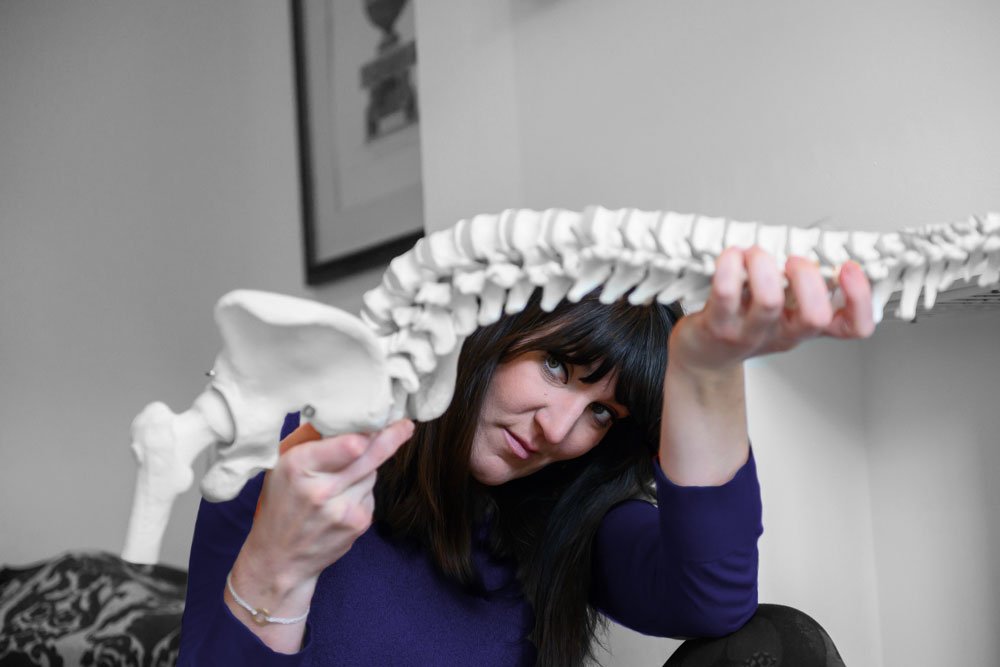

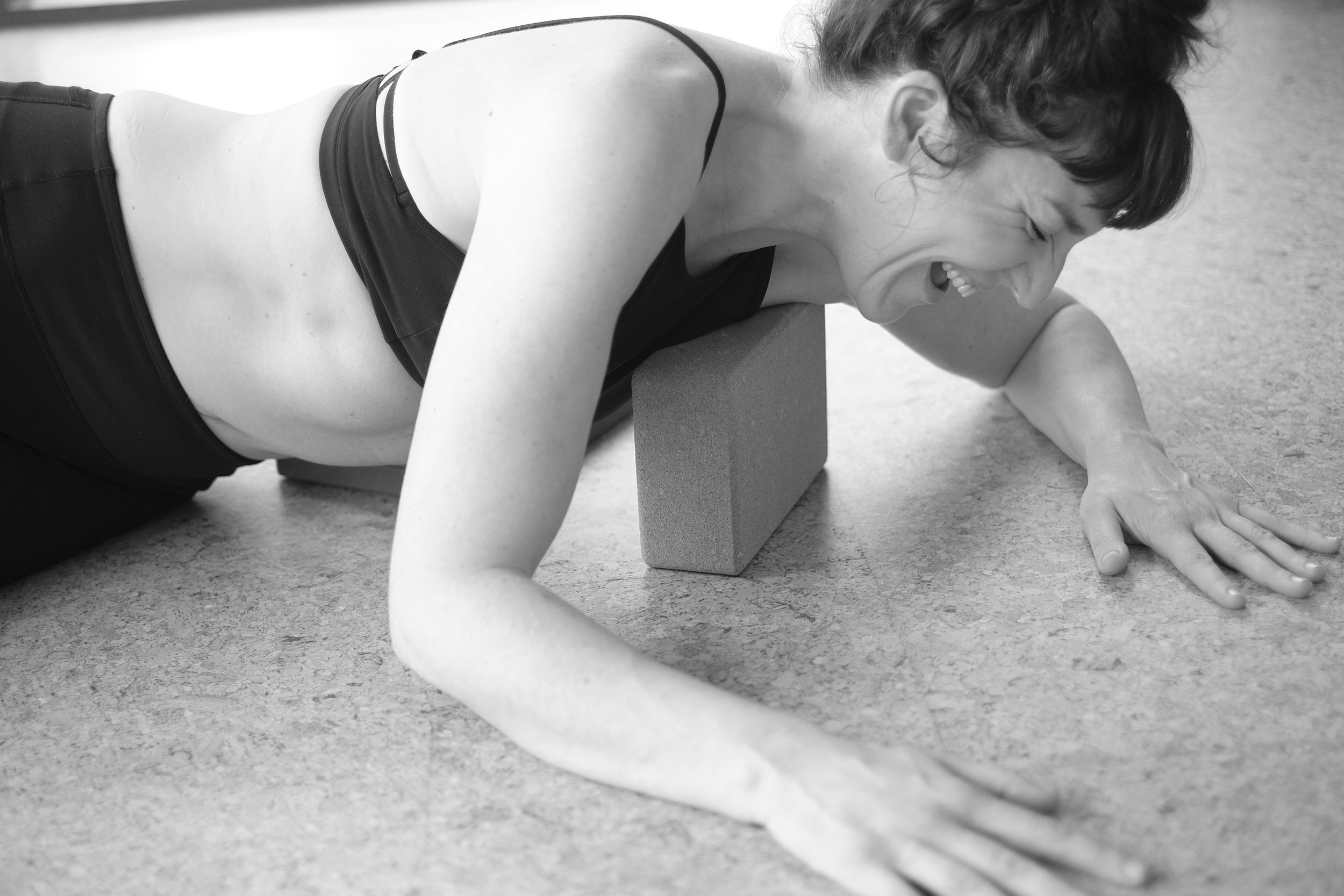


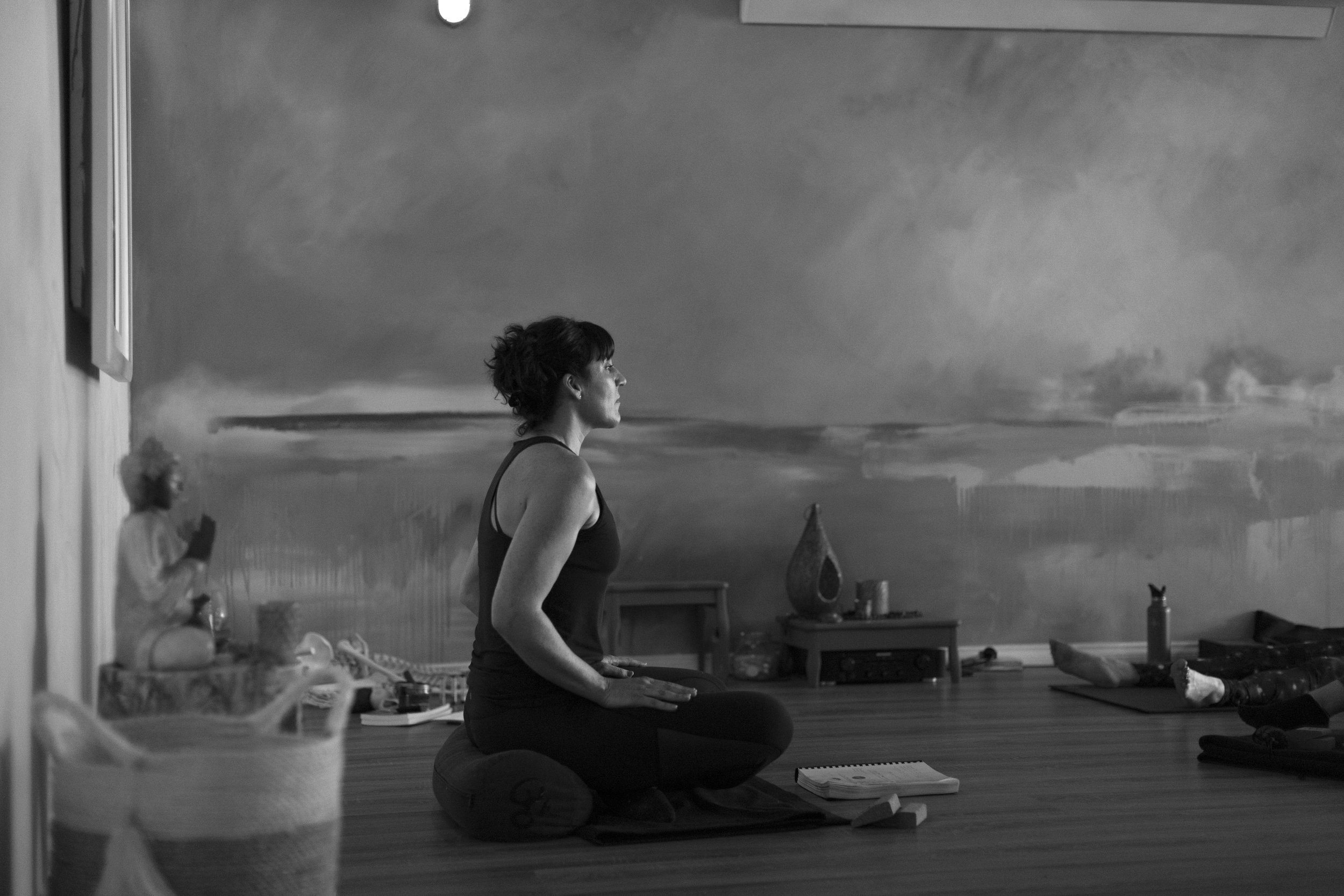
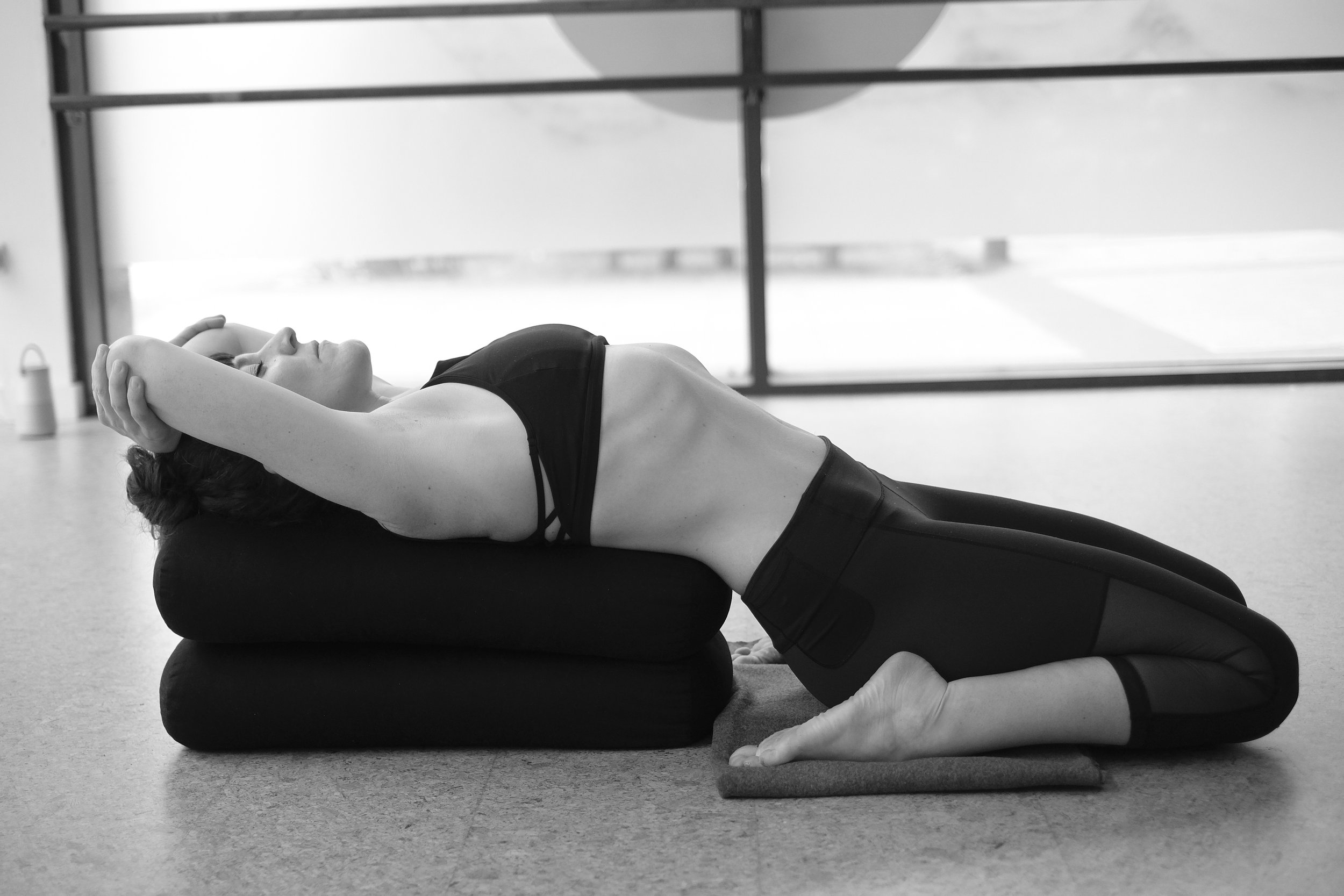
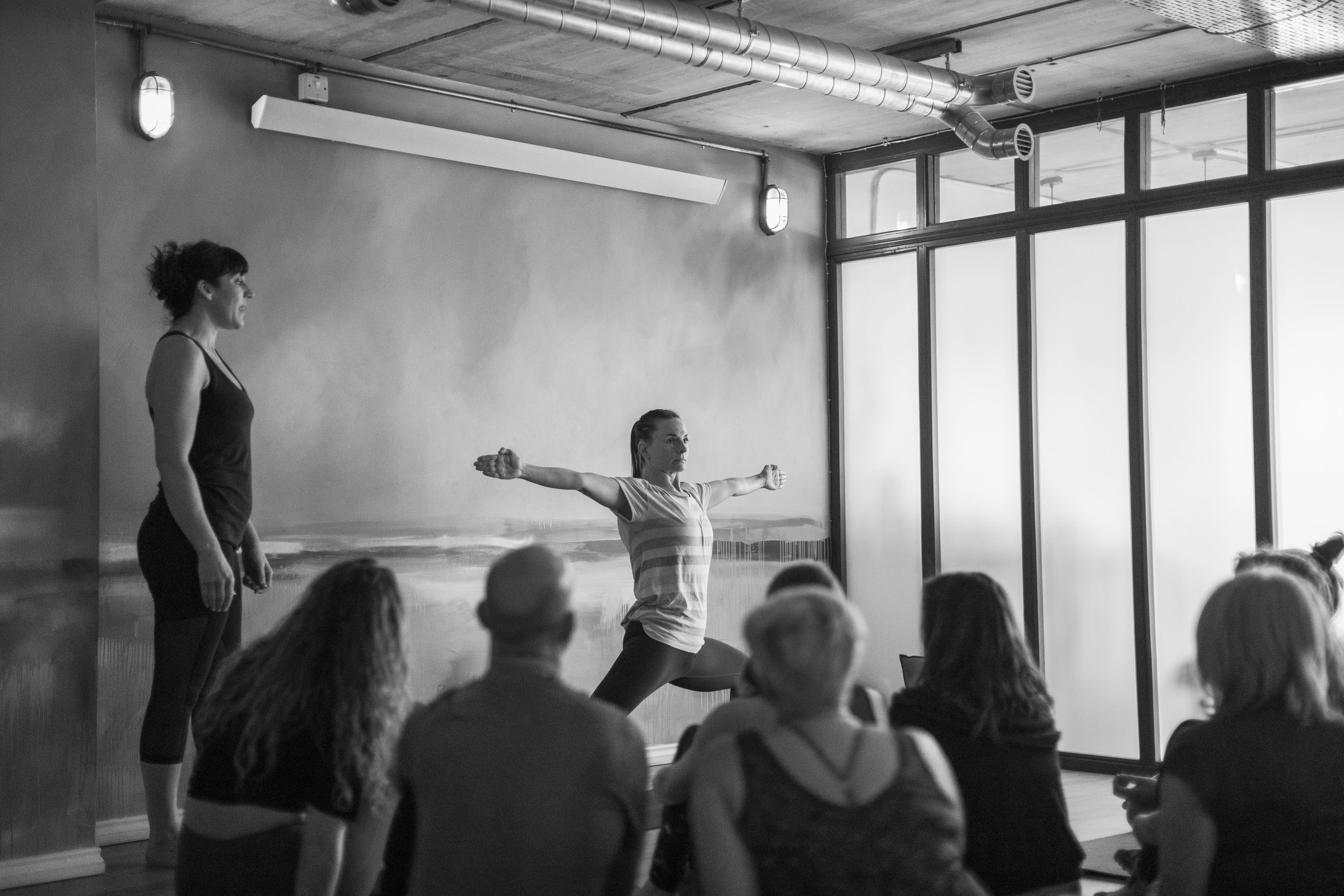



Functional Yoga Integrated
A 300hr Yoga Teacher Training, comprising three 100hr modules
If you are new to the Grace Tempany Method and are unsure which path to take between Functional Yoga and Body Therapy (Soma Talk), don’t worry: The Art of Yin is the first module in both!
Start there to gain a more than sufficient foundation in both modalities. By the time you have completed the Art of Yin training, you will have a better idea towards which of the two pathways you are being led.
-

Art of Yin 100hr
Part 1: Lower Body Yin
Part 2: Upper Body Yin
Part 3: From Feeling to Healing: Yin through a Trauma-Informed Lens. -
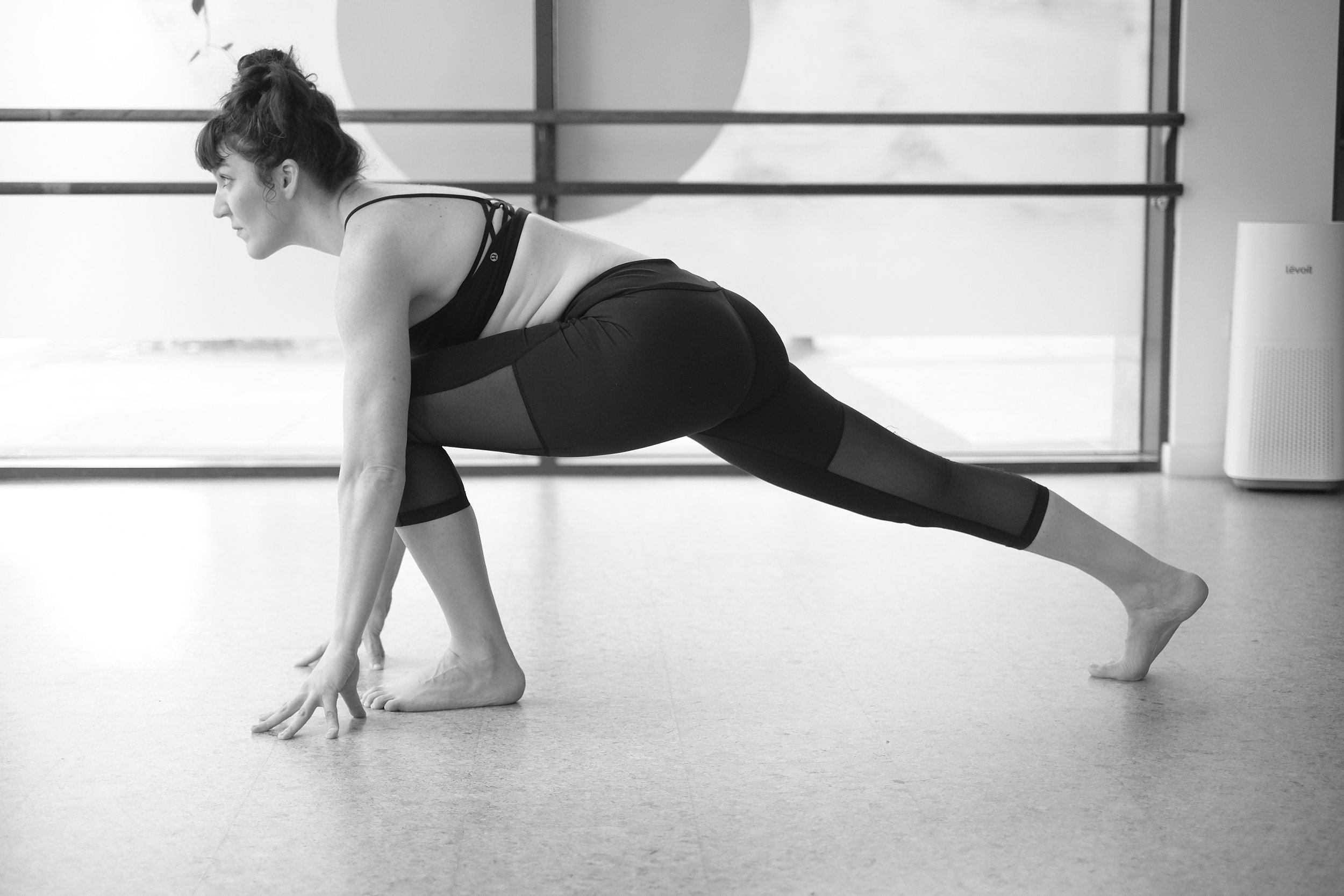
Art of Yang 100hr
Part 1: Functional Hatha as Yoga Therapy
Part 2: Myofascial Release, Breathwork & Fascia in Movement -

The Art of Teaching 100hr - choose any four 25hr modules
1: The Art of Body-Reading
2: The Art of Deep Rest
3: The Shadow in the Body
4: Bridging Felt Body and Felt Sense 5. MyoYin

“I am more me now than I have ever been. You Grace, and your Yin training, have been a very big part of my personal growth journey”
– Ber McCall, The Art of Yin, 2024 (on the Soma Talk pathway)
Art of Yin 100hr Yoga Teacher Training
The Art of Yin is a complete grounding in the yin yoga practice through a functional and deeply therapeutic lens. An initiation to leadership, growth, teaching and soul purpose, it is the only 100hr Functional Yin Yoga Teacher Training taught by a Senior Teacher & Trainer Pro with Yoga Alliance Professionals.
World-class teaching is much more than delivering content. Those I teach, train, mentor and guide, are on a path to uncovering their own voice and inner teacher. They are already courageously and whole-heartedly walking their unique individual path. The Grace Tempany Method & The Art of Yin are a firm but excessively gentle hand or a star as a point of reference as you tread the steps that only you can tread.
“Good teaching cannot be reduced to technique; good teaching comes from the identity and integrity of the teacher.” - Parker Palmer
Are you drawn to begin the journey on the Yinside?
Are we a fit?
Have you ever felt confined within or frustrated by the excessive aesthetic focus that dominates much of the modern yoga world?
Are you ready to uplevel your teaching skills and step fully into the seat of the teacher?
Does Yin reach you on a below the surface level? And are you only interested in embodying and transmitting it from a place of grounded self-awareness?
If it’s a Yes to even one of these, it’s a fit!
The Seven Ss of Yin Simplicity
When at your seven of sensation, you can settle and find stillness, and surrender into silence, you’ll find solace
2026 Dates
Part 1 (Sep 18-20): Functional Yin Foundations - Lower Body Surrender
Part 2 (Oct 16-18): Upper Body Explorations
Part 3 (Nov 14-15 & 21-22): From Function & Feeling to Trauma & Healing
“Teach only what is appropriate to the individual”
-
Part I: Lower Body Surrender
Philosophy, Vision and Core Tenets of the Yin Practice
Function or Aesthetics: The Unlearning begins
Asana Lab: Lower Body Yin Poses and Functional Prop Usage
Hip Anatomy: The Functional Approach – Anatomy and Skeletal Variation
Traditional Chinese Medicine (TCM): Lower Body Meridian & Target Area Mapping
Rebound: Our essential component in tying the energetic and emotional bodies together
Exploring the Mind – Considering the value of a yin approach to meditation
The Teaching of Yin in Specific Contexts
Yin Teaching Skills: Potential Challenges & Exploring The Courage to Teach
Part II: Upper Body Explorations
Consolidating the Functional Approach to the teaching of Yin
Asana Lab: Upper Body Yin Poses and Functional Prop Usage
Shoulder Anatomy: The Functional Approach – Anatomy and Skeletal Variation
TCM: Upper Body Meridian & Target Area Mapping
Rebound Considerations 101 - Melting Heart Explorations
Acupressure for greater feeling and emotional healing
Meditation – Tuning into the witness
Self-Inquiry: Introducing the Shadow: Yin & Jung
Yin Teaching Skills: Target Area Consolidation & Verbal Cueing
Part III: From Function & Feeling to Trauma & Healing
14-10-7 and Paul Grilley’s Functional Yoga Sutras
Asana Lab: Poses for the Spine
Spine Anatomy: The Functional Approach - Anatomy and Skeletal Variation
TCM: Governor & Conception Vessels, Taoist Inner Alchemy Practices & Chakra Psychology
Yinteroception, Somatics & The Wisdom of Rebound
Meditation - Vipassana
Are you Trauma-Yinformed? Yin as the Gateway Practice to Embodied Healing
Yin Teaching Skills: The Inner Teacher & Refining Teacher Voice
-
I’m so yinterested, but I don’t teach yoga currently. Can I sign up?
Absolutely. This is not a problem for committed practitioners. On nearly every training I have run there have been participants who did not desire to teach. Some do change their mind throughout the course of the training, but many are content to be immersing themselves in the practice they love, and they embark on the journey for the contemplative opportunities and practices that the training provides. If you have questions, why not book in for a discovery call?
Do I need to have completed a 200hr general yoga training when I enrol?
Not at all. Because I prioritise everyones’ personal yin practice and teaching practice, each teacher leaves with a much stronger connection to their bodies, irrespective of their former training. The Art of Yin involves a fair amount of unlearning, and that is the common denominator irrespective of how much training you have completed prior. All real learning starts with embracing your ‘tabula rasa - beginner’s mind’, and calling on your discernment as you progress through the content, practices and teachings.
That being said, should you be a graduate of a 200hr training, and working towards 500hrs, the 300hr Functional Yoga Integrated programme is likely to appeal. After The Art of Yin, you can continue to The Art of Yang and The Art of Teacher. All three modules offer the only functional 300hr in Ireland, and I believe also in the UK.
Is there any recommended reading for The Art of Yin?
You will be provided with a manual and plenty of support learning materials. Should you want to do some extra reading in preparation, I have chosen a book to accompany each of the 3 parts:
The Complete Guide to Yin Yoga by Bernie Clark
Insight Yoga by Sarah Powers
Trauma-Sensitive Yoga in Therapy: Bringing the Body into Treatment by David Emerson
How is Part 2 different to Part 1?
To break it down in very simple terms, Part 1 covers hip anatomy and lower body yin poses while Part 2 covers shoulder anatomy and upper body yin poses. Part 1 is lower body meridians while Part 2 is upper body meridians. Part 1 provides the thorough grounding in the practice which is essential in order to embody it from a place of integrity. Part 2 takes you on a journey deeper into meditation, shadow exploration, and fine-tuning your teaching language.
Speaking of (y)integration, what about Part 3?
Part 3 has a truly beautiful symmetry to it in that it brings to completion the functional approach vision with 14-10-7, Paul Grilley’s Functional Sutras, and the deconstruction of the archetypes. From there we dive into the spine and the Daoist energetic and meditative practices. From rebound to interoception and culminating in the relevance of the deeply feeling yin practice for trauma access and recovery, the final piece of the journey dials up the personal commitment a notch. You are more than ready for it now. The journey deepens from shadow to dissociation, and the magic potency of yin as the ultimate somatic practice of integration is unveiled. By the end of Part 3, there is no doubt in your minds, hearts and souls that yoga can be therapeutic. But much more than that, you are likely to leave with the deeply felt sense that Yin may just be the original yoga therapy. Practising and mastering trauma-yinformed teaching is where I envision you as you depart.
Can I start teaching yin yoga straightaway?
This is such a personal and deeply individual question. I encourage all trainees to start teaching as early as possible (family and friends and your other training friends) so as to gain in experience and confidence. However, it is probably advisable that you make your regular yin practice your main priority for the months directly following the training. This is why the 6-month deep dive container includes the possibility to practise and be mentored with me within The Integration Space. This will help you get a felt sense of all aspects of the yin practice, and your teaching will be all the better as a result. You can only teach well what you regularly practise.
What does training with a professionally qualified teacher mean for me as a trainee?
It’s the professionally trained and experienced teachers who are best equipped to train yoga teachers. Quite simply, they have the pedagogical skills to do so.
Founder of Functional Yoga Integrated, Grace Tempany has 12 years experience in the secondary education world. She has always felt that there is a deep need for educators in the yoga education world. It can be difficult to find teacher trainings that succeed in marrying intellect with the wisdom of the body. At FYI we believe it can and should be done and it is our work with every student that crosses our path.
It is this vision that inspired Grace in the creation of the Grace Tempany Method.

Upcoming Training Calendar
-

Part 1: Functional Yin Foundations
30 hours in-person immersion
(serves as Part 1 of the Art of Yin YTT)
Kildare: March 6-8Dingle: May 21-14 (3 nights residential)
Belfast: June 12-14
Sligo: July 10-12
-

Parts 2 & 3: Art of Yin Online
70 hours online (for those completing Art of Yin 100hr YTT ) plus 6 months membership of The Integration Space
For trainees completing Functional Yin Foundations in Kildare, Dingle, Belfast or Sligo.
October 16-18
November 14-15 & 21-22
-

Complete Art of Yin (100hr) Online
All 3 parts (full journey) completed online plus 6 months membership of The Integration Space
For trainees completing the full 100hr training (all 3 parts) online
September 18-20,
October 16-18
November 14-15 & 21-22
Art of Yang 100hr Yoga Teacher Training
If yin is stillness, yang is movement.
At some point on the journey post Art of Yin training, as long as teachers continue to practise and self-reflect, they realise that functional yin facilitates not only greater freedom and inclusion in teaching, but that it represents an effective and highly therapeutic avenue towards instilling student self-empowerment. The next step is to consider the application to more yang practices.
How do I take my Art of Yin knowledge and skills and apply them to hatha, vinyasa, myofascial release?
How do I take what I understand about skeletal variation and make the functional purpose of the pose the bedrock of all my teaching; yin & yang, stillness & movement?
If the above two questions have arisen in your mind, then The Art of Yang is for you.
This comprehensive training is designed to meet the very real and contemporary needs of yoga practitioners and those who guide them. The Art of Yang brings you from master of yin yoga to master of all yoga. After we integrate the stillness it is time to apply the individually-tailored and therapeutic principles to movement.
Overview
Part 1 (60 hours): Functional Hatha & Vinyasa, 26&2, Purpose & Target Areas for Yang Poses, Paul Grilley Yang Flows
Part 2 (40 hours): Myofascial Release, Breathwork & Fascia in Movement
2026 Dates
Part 1: June 19-24, Marino Institute of Education, Dublin 9.
Part 2: Sep 5-6 and 12-13, Zoom Online.
“We don’t use the body to get into a pose. We use the pose to get into the body”
-
Functional Hatha as Yoga Therapy
60 hours
Functional Yang Yoga through a therapeutic lens
Philosophy:
Functional Yoga origins and Yoga Therapy origins - the same?
From Krishnamacharya to Paul Grilley’s Functional Sutras.
The history and evolution of yoga therapy, and how things have greatly changed since “teach what is appropriate to the individual” (Krishnamacharya)
Physical Layer - Anatomy:
Paul Grilley’s 14-10-7 Model extended
Compression as the starting-point.
Upper Body Muscle Explorations
Upper Body Joint ranges of motion
Asana Labs:
Bishnu Ghosh’s 26&2 - An Intro
Additional hatha pose breakdown through the Grace Tempany Method TAPAS & NIDRA lens (approximately 40)
Functional Sun Salutations
Paul Grilley’s yang flows
Teaching Skills:
Goniometer tests for range of motion assessments
Deconstructing traditional “universal alignment” cues
Functional style yang teaching principles
Teaching Practice:
Group
1:1
Creating sequences from Yang to Yin to an energetic curve
-
Myofascial Release, Breathwork & Fascia in Movement
40 hrs live on Zoom
This four-day online immersion explores movement and breath as medicine. It deepens the functional foundations laid in The Art of Yin and Part 1 of The Art of Yang (Functional Hatha & Vinyasa).
Rooted in the work of Tom Myers (Anatomy Trains) and Paul Grilley’s functional model, this training investigates the living architecture of the upper body - its fascia, muscles, and connective tissues that integrate the shoulders, chest, arms, and spine into a unified field of movement.
Fascia is studied and experienced as both structure and sense organ - the body’s largest communication network. We explore its viscoelastic and thixotropic properties, its responsiveness to pressure and load, and the interoceptive intelligence it holds. Through myofascial release and subtle inquiry, students experience how load, direction, and breathwork reshape the tissues and, in turn, the nervous system.
Through classical pranayama practices, you will learn to perceive how the respiratory diaphragm interfaces with the fascial system, influencing tone, regulation, and flow.
Energetic Layer - Somatic Breathwork:
Pranayama
Nadi shodhana
Breath retentions
Kapalbhati
Energetically, The Art of Yang situates itself within both Tantric and Daoist lineages with prana and qi, and chakras and meridians clarified as expressions of the same continuum. The training invites an understanding of vitality not as force, but as coherence - the felt integration of fascia, breath, and consciousness.
The Grace Tempany Method in Motion
The entire training is infused with the Grace Tempany Method, the pedagogical architecture that threads through all of Grace’s work in The Art of Yang:
PASTA – Physical Purpose, Action over Appearance, Sensation, Target Area.
A method for cueing and functional movement that privileges awareness and intention over performance.
NIDRA – Nuance, Inquiry, Discernment, Raise Awareness.
The reflective phase following activity, where resonance becomes understanding. NIDRA is the methodology for the rebound when to comes to The Art of Yang.
CEC → CDS – Contraction, Engagement, Commitment within the pose to cultivate Compassion, Determination, and Strength in life.
Building on the purpose-focused deconstrction of hatha poses in Part 1, Part 2 completes the fascia-sensitive, breath-infused pedagogy that bridges anatomy, energetics, and inner awareness, cultivating discernment, depth, and agency.
For Teachers and Practitioners
This module deepens the skillset of yoga teachers and movement professionals seeking a functional, evidence-based, and breath-informed approach to fascia.
You will leave with the ability to integrate active myofascial release and pranayama safely and creatively into your teaching, refining the art of Yang as conscious, intelligent motion
-
I have not completed the Art of Yin. Can I just do The Art of Yang?
In a short answer, no. The Art of Yang is Module 2, building on and beyond teh foundations established in The Art of Yin. Because all the teaching at FYI is functional (not based on universal alignment notions, and speaking to feeling over form), it stands out in the yoga industry at large. It is not possible to enter into The Art of Yang without having established a foundation in functional and therapeutic principles.
Is there any recommended reading for The Art of Yang?
You will be provided with a manual for each module, verbal cues, and a clear functional guide for the yang practices that we are looking at. Should you want to do some extra reading in preparation, I can recommend the following. The first 2 on the list would be a good place to start. The last three are dense, and I will present the essentials to you during Module 1 anyway, so only dive in if the desire is strong! :-)
Yin Yoga: Principles and Practice by Paul Grilley
Yoga Body: The Origins of Modern Posture Practice, by Mark Singleton
Your Body, Your Yoga, Bernie Clark.
Your Spine, Your Yoga, Bernie Clark.
Your Upper Body, Your Yoga, Bernie Clark.
How much does yoga therapy come into this?
We can say that functional yoga and yoga therapy have the same roots - Krishnamacharya’s “teach what is appropriate to the individual” is what inspired the branch of study known as yoga therapy today. However, as a field, yoga therapy has I think become very focused on the physiological.
FYI and the Grace Tempany Method aspire to bring more of the emotional and psychological to the fore. We speak a lot in yoga about transformation, but we cannot change anything we do not first accept. Self-inquiry and inner work are therefore cornerstones of all FYI trainings. You are supported to engage in your own personal journey as you embark on and proceed through the training.
Please note that this training is in no way a replacement for personal therapy, but I can say with certainty that it is a hugely complementary somatic addition.
How much does anatomy matter in this course?
The anatomy you are taught is functional and target area focused. Essentially, it is variable. You will learn that we are not all carbon copies skeletally. The approach to the teaching of anatomy can be summed up by Paul Grilley:
“When you learn to see the body as 14 skeletal segments. being moved by 10 myofascial groups, you will be able to skillfully adapt the 7 archetypal poses to suit the skeletability and flexibility of each individual student”
This is to say that the anatomy you learn immediately serves a purpose. There is no learning for learning's sake. Every single joint, bone, muscle, or myofascial group we look at is applied to poses, be they within the yin or yang practices.
How can you teach to the individual when you have 15 students in a room?
A lot comes down to your skillset, and language is by far the most important of these teaching skills. We can never know for sure what our students are experiencing, but we can help them become empowered practitioners with our cues to feeling and excellent questions. This is why language is a central focus within Functional Yoga Integrated.
What does it mean to be a Functional Yoga Teacher within the Grace Tempany Method?
To be a functional teacher is to teach to feeling, with the experience of each individual at the centre of the teaching, and to teach through a therapeutic and trauma-aware lens. To be a functional teacher is to embrace your personal practice as your own greatest teacher, and to confidently yet humbly guide your students to connect on a much deeper level with themselves and those around them
How is The Art of Yang different to most other yoga teacher trainings?
The Art of Yang is functional first and foremost. “If you’re feeling it, you’re doing it” - everything you will be taught can be distilled to this. Functional Teaching means teaching to the individual, teaching to feeling over form. This can be a departure from most rigid, universal alignment teachings, but nearly all students resonate hugely with this approach within their own experience, and speak to feeling much more confident in their teaching post-training.

“This training will transform how you teach yoga to your students. The depth of knowledge which is covered in this course far exceeded my expectations, and I now teach my classes, both yin and yang, from a more functional and inclusive point of view”
– Edward Hogan, The Art of Yin & The Art of Yang 2023 (on the Functional Yoga Integrated pathway)
Art of Teaching 100hr Yoga Teacher Training
Congratulations! Having completed The Art of Yin and The Art of Yang, you are now grounded in the content, the what.
The Art of Teaching addresses all things teaching skills and language on one hand, and unveils the identity, integrity, and leadership journey of the teacher on the other.
In other words, having addressed the what, you are now ready to dive into the how, the why and the who.
Pedagogy
Learn how to teach, and hold the student’s unique experience at the centre of that teaching, so Functional Yoga: Integrated is experienced as the healing and transformative practice it has the capacity to be. Master the art of how you do what you do.
Presence
Embrace self-knowledge and self-reflection; come to realise that you teach who you are, and why you’re teaching, long before you teach what you know.
Art of Teaching Trainees should choose any four 25hr modules.
Overview
Part 1 (25 hours): The Art of Body-reading, verbal direction through an accessible and trauma-sensitive lens
Part 2 (25 hours): The Art of Deep Rest, 3 Schools of Yoga Nidra, Hypnosis and Psychosomatic Analysis
Part 3 (25 hours): The Shadow in the Body, Yindividuation, finding the gold
Part 4 (25 hours): Bridging Felt Body and Felt Sense, FocusYin, tackling dissociation
Part 5 (25 hours): MyoYin, a modality blending Yin with myofascial release balls, as we journey psoas-diaphragm-vagus & the deep front line through a FATE lens.
“Teaching holds a mirror to the soul. If I am willing to look in that mirror and not run from what I see I have a chance to gain self knowledge and knowing myself is as crucial to good teaching as knowing my students and my subject. In fact, knowing my students and my subject depends heavily on self knowledge.”
-
If The Art of Yin is Stillness & The Art of Yang is Movement, then The Art of Teaching is the how behind the effective and embodied sharing of them both. It is through deepening ones’ teaching skills (the how) that the person (the who) and the purpose (the why) emerge with clarity.
Within the Grace Tempany Method, teaching is an art form, a craft, a continually evolving practice, but first a foremost, it is a set of skills to master. The Art of Teaching, the third module in the journey to embodied and integrated teaching is designed to help you do just that.
It will equip you skills that are often neglected in yoga teacher trainings. To put it as simply as possibly, The Art of Teaching will make you a teacher.
One must be taught how to teach. Only a few rare people in this life possess this skill innately - and often those innate teachers are the most devoted to their continual growth and development. Nearly 70% of yoga instructors leave their 200 hour feeling ill-equipped in the method and practice of teaching.
The Art of Teaching is one of the many ways that Functional Yoga Integrated is set apart from other yoga teacher trainings who concentrate only on the what, and fail to address the how, the who, or the why.
The Art of Teaching addresses all things teaching skills and language on one hand, and unveils the identity, integrity, and leadership journey of the teacher on the other. In other words, having addressed the what, you are now ready to dive into the how, the why and the who.
Pedagogy
Pedagogy: noun - “the art, science, or profession of teaching”
“The study of teaching methods, including the aims of education and the ways in which such goals may be achieved. The field relies heavily on educational psychology, which encompasses scientific theories of learning, and to some extent on the philosophy of education, which considers the aims and value of education from a philosophical perspective.”
Learn how to teach, and hold the student’s unique experience at the centre of that teaching, so Functional Yoga Integrated is experienced as the healing and transformative practice it has the capacity to be. Master the art of how you do what you do.
Presence
Embrace self-knowledge and self-reflection; come to realise that you teach who you are, and why you’re teaching, long before you teach what you know.










